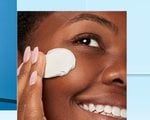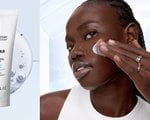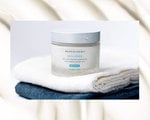How To Reduce the Appearance of Pesky Ingrown Hairs
October 31, 2024What Is an Ingrown Hair?
An ingrown hair is a strand of hair that grows back into or gets trapped beneath the skin after hair removal. When this occurs, a small bump—usually reddish or brownish in color—develops over the hair follicle. These bumps are often referred to as razor bumps, though, as the Mayo Clinic notes, they can also develop after waxing or tweezing your hair.
What Causes Ingrown Hairs?
Nearly any form of hair removal can lead to an ingrown hair. Normally, when hair grows, the tip of the strand emerges from the skin and continues to grow outward. In some cases, though, the tip can curl over itself and grow back into your skin. When this happens, the area may become red and irritated. While anyone who shaves, plucks, or waxes their hair can develop ingrowns, they’re most common among those with coarse, curly hair, per the Cleveland Clinic.
Do Ingrown Hairs Go Away On Their Own?
Ingrown hairs often resolve by themselves after a week or two, the Cleveland Clinic notes. However, the discoloration they leave behind can linger for months or more. To avoid worsening ingrown hairs, don’t squeeze, pick at, or try to pop them—doing so can further irritate your skin. If the area around the ingrown hair is painful to the touch or accompanied by pus (or the ingrown hasn’t resolved itself within a few weeks’ time), it may be a good idea to schedule a visit with your dermatologist.
How Do You Get Rid of Ingrown Hairs?
If you notice an itchy red bump appear after shaving or waxing, don’t stress—there are a few things that you can do to help address the issue at home.
Start by adding exfoliation to your regular routine. Exfoliating helps remove dead skin cells, which can help the hair release on its own. If the ingrown hair is on your face, lather up with a gentle, non-abrasive exfoliating cleanser. We recommend the Kiehl’s Facial Fuel Scrub, which sloughs away dirt and oil and helps minimize ingrown hairs (and other shaving-related skin irritations).
For your body, you could use a body scrub or opt for an ingrown hair treatment like the Kiehl’s Ingrown Hair and Tone Correcting Intimate Drops. This quick-drying formula, which contains jojoba oil and a trio of alpha-hydroxy acids, helps minimize the appearance of ingrown hairs and promotes a more even skin tone—a serious bonus for those prone to dark spots. It’s suitable for all skin types and can be used anywhere you typically get ingrowns, including the armpits and bikini area (it’s dermatologist and gynecologist-tested for safety). To use it, vigorously shake the bottle, then dispense a few drops onto your fingertips and pat the fast-absorbing formula onto clean, dry skin.
If at-home treatments don’t seem to help much, consider scheduling a visit with your dermatologist. A board-certified dermatologist can remove ingrown hairs, even deep ones, safely. If the area is highly irritated, they may also prescribe an ointment or cream to help your skin recover.

How To Prevent Ingrown Hairs: 7 Tips
We could sit here and list out all our picks for the best products for ingrown hairs—there are plenty out there—but really, the best way to manage ingrowns is to adopt habits that can help prevent them from occurring. Here are seven tips to help you do just that.
1. Use shaving cream or gel
If you shave, prepping the area with shaving cream is a must. Shaving cream provides slip, which helps ensure the razor glides evenly over your skin. This, in turn, helps reduce the risk of cutting your hair unevenly or having to shave over the same area multiple times. It also helps minimize the risk of other shaving-related concerns, like razor burn (which can be just as frustrating to deal with as razor bumps).
2. Shave in the direction of hair growth
Shaving “against the grain” (in the opposite direction of hair growth) may get you a closer shave, but it also increases your risk of developing ingrown hairs. That’s because shaving against the grain cuts the hair at a sharp angle, which increases the likelihood that the tip of it will pierce your skin as it grows back. To keep ingrowns at bay, it’s best to shave in the direction of hair growth.
3. Replace your razor
According to the American Academy of Dermatology (AAD), shaving with a dull blade significantly increases the risk of developing razor bumps. Aim to swap out your razor—or replace the blades—after every five to seven uses to ensure you’re shaving with a clean, sharp blade.
4. Exfoliate regularly
Exfoliation isn’t only useful for managing existing ingrowns—it can also help prevent dead skin cell buildup that makes developing ingrowns more likely. You can exfoliate with a washcloth or loofah, but the AAD suggests opting for a gentle chemical exfoliant if you have dry or sensitive skin. Consider swapping out your go-to cleanser for an option with alpha-hydroxy acids (AHAs) or beta-hydroxy acids (BHAs). One exfoliant we’re fans of is the Youth to the People 10% AHA + Yerba Mate Smoothing Energy Body Scrub. The formula, which features both physical and chemical exfoliants, helps unclog congested pores and smooth rough texture and bumps. It also features an energizing fragrance with notes of spicy black pepper, ginger, and velvet woods—perfect for elevating your shower routine.
5. Use a post-shave treatment
Whether you shave, wax, or tweeze, it’s a good idea to follow up your hair removal method of choice with a targeted treatment designed to help keep ingrowns and irritation at bay. A good cream for ingrown hair prevention will typically contain gentle exfoliants, such as alpha-hydroxy acids, alongside hydrating ingredients to help soothe the skin. The best lotion for ingrown hair will depend on your skin type and the area you’re looking to treat. Kiehl’s Ultimate Razor Burn & Bump Relief is a great pick for those prone to ingrowns on the face and neck (in other words, the beard area).
If you’re looking to prevent ingrowns on your bikini line, use something made specifically for that delicate area. We love the Fur Ingrown Concentrate, which according to the brand can be used daily or as needed on the pubic area, underarms, legs, or anywhere else you’re prone to redness and irritation.

6. Trim instead of shaving or waxing
Shaving, waxing, and tweezing remove the hair at the surface of the skin or lower, which increases the risk of it curling back into your skin as it grows out. If you’re having a hard time with ingrowns, consider trimming your hair instead—you won’t get that silky-smooth, hairless feel, but your risk of developing painful razor bumps will likely decrease.
7. Consider permanent hair removal
Permanent hair removal—like electrolysis or laser hair removal—destroys the hair follicles so hair can no longer grow from that area. With no hair to remove, you won’t need to shave, tweeze, or wax—which, by extension, decreases your risk of developing ingrowns. Keep in mind that permanent hair removal can be very costly, and efficacy may vary depending on your skin tone and hair type. If you’re considering taking the plunge, speak with your dermatologist beforehand and make sure to get your treatments with a well-established, licensed hair removal technician.
Next Up: 12 Tips to Care for Your Skin Before and After a Wax
EXPLORE BY TOPICS AND BRANDS
- body-care
- Hair Removal
- video-embed
- Embedded Video
- Kiehl’s
- Youth To The People




























